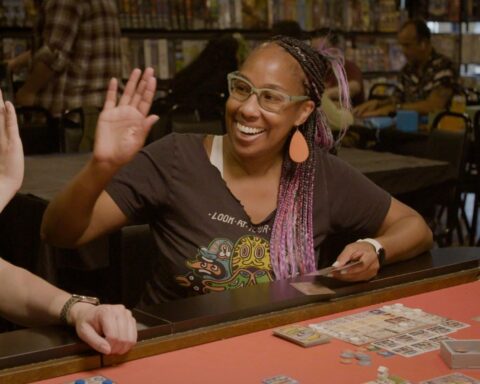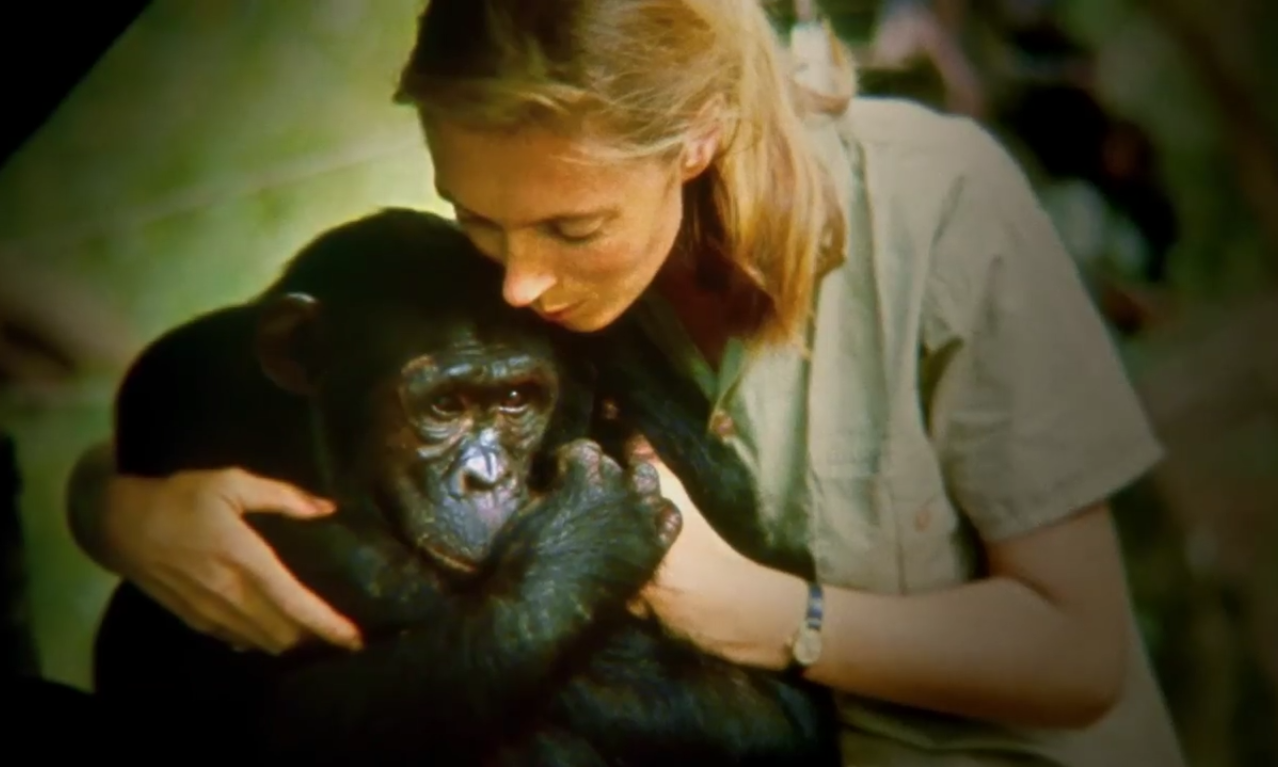Launching TIFF’s doc section, Sophie Fiennes’s film Grace Jones: Bloodlight and Bami gave the audience at its first public screening the taste of ecstasy they hoped for. Both Fiennes and the living icon revelled in the wave of excitement that crashed through the Elgin.
Driven by the almost 70-year-old Jones’s unstoppable energy as a performer and human being, her still powerfully gorgeous body, and her sleek sexuality, the movie was a dream project for Fiennes that she immersed herself in for ten years.
For one thing, “I love being in Jamaica,” the director told me a few days after the debut. Even before embarking on the project, she had been all over the island “scouting locations for advertising shoots. With Grace, I travelled around Jamaica, getting a different access to it, a different sense totally. It was brilliant to see it through her eyes.” Jones is deeply rooted to the island where she was born. Fiennes filmed the Spanish Town streets that she grew up on, the mountain countryside, and other locales that pulse with life, but are not postcard pretty.
Fiennes recalls a moment when Jones talked to Dickie Jobson, director of the 1982 film Country Man, a cultural milestone on par with The Harder they Come. Laughing, Fiennes imitates Jones swinging into Patois inflection: “Jamaica is the umbilical cord. When they out of tings to sing about they come back to the umbilical cord, and they cut it up, and eat it like sausage.” A supremely cosmopolitan woman who has lived in London, Paris, and New York, Jones returns to the blessed isle as often as she can. “She just loves it,” says Fiennes. “She recharges.”
Apart from tracking Grace Jones’s experiences in Jamaica; her interactions with family, friends, and former neighbours; and memories of her cruelly abusive step-grandfather Mas P, Bloodlight and Bami zeroes in on what Fiennes calls “the contrapuntal tension between the fragility of daily life and what the performer is doing on stage.”
Fiennes crosscuts between cinema verité footage of her subject dealing with money and personnel issues, and stylized sequences of the singer and dancer on stage. In concert footage shot in 2016, Jones struts and stalks wearing flamboyant hats, corsets, and low-cut, high-on-the-thigh one-pieces, the kind favoured by party-going Jamaican women a fraction of her age.
“I wanted to bring into the film that incarnation of Grace,” says Fiennes. After years of tracking Jones, “I said to her, ‘I can’t complete this film without your performance, and I can’t shoot your performance in a random way.’”
Fiennes continues: “I’ve watched her perform a lot of music festivals with all this stuff on the stage. If you film that, you see all these bits of rubbish behind her.” Fiennes and her crew staged Grace Jones’s performances in an Irish theatre where they could orchestrate every detail. She wanted her musical sequences, shot on Super 16, to look “classic and theatrical.”
The doc eschews vintage footage of its star. You don’t see much Grace Jones of the 1980s or 90s. “It’s all on YouTube,” says Fiennes. “We made our own material.” Why work with the performer for years and load up on sound and images from the past? “This is not a nostalgic film. It’s a film in the present tense, in the moment. Someone else can make that other kind of film. It just doesn’t interest me.”
The sister of actors Ralph Fiennes and Joseph Fiennes, Sophie’s restless, adventurous spirit originates in her childhood. “As a family we moved around a lot, and I never stayed anywhere very long. I’m a gypsy who grew up in small provincial English towns, and in the west of Ireland. Very rural, really undeveloped, like parts of Jamaica in a way.”
Fiennes “wanted to be a filmmaker from about the age of 14. I was babysitting, and I saw The Enigma of Kaspar Hauser on TV. It was like you get grabbed by something. That’s what I wanted. This is a language. This is a place. A world that I knew I wanted to explore.”
What was it about Werner Herzog’s movie that cut so deep?
Fiennes was taken by “the opening shot of the cornfield blowing, the way that he held the shot, and something happened and changed, and there was a possibility to surf that moment in the film, that image, and wonder and respond. I was taken into a filmic world that wasn’t like anything else I had seen.”
Over the years, Fiennes has “worked in photography, in fashion, and on fiction films with Peter Greenaway.” The experiences coalesced into “a snowball of skills, and knowledge, and interests. It’s great when you do different things in your early years, and you bring that experience to what you make. When I was filming the performance sequences, I was really happy that I had done a one-week workshop with a brilliant lighting designer called Jennifer Tipton, who worked with Twyla Tharp and Bob Wilson. All of that information bubbled up in me as I created that show.”
Throughout Bloodlight and Bami, which refers to the Now Recording signal in a Jamaican sound studio and flat bread often eaten with fish, Grace Jones appears in her typically flamboyant costumes, or looking like she could be a yardie. She’s masked and unmasked, covered and uncovered.
A couple of years ago, I said to a Jamaican woman, “You are all shape shifters.” She laughed and nodded. Grace Jones is the empress of shape shifters. I told Fiennes that for me, the film undercuts judgemental clichés about makeup and other ways women design a look. Fiennes implies that Jones’s masks and costumes are not a way of hiding. In fact, they reveal.
“Absolutely. Thank you. That is the intent of the film really, what you picked up. You might want to say here is the real person behind the mask, but it’s really a dialogue.”
That dialogue can trigger a powerful force. “What is the iconic thing?” Fiennes asks. “It’s something we believe. An icon is a point of belief. It has awakened our imaginarium. It’s not actually in an archive. It’s in our excitement. In our pleasure of how Grace has reproduced in all this shape shifting.”
Sophie Fiennes’s previous work included her collaborations with the radical philosopher Slavoj Zizek: The Pervert’s Guide to Cinema (2006) and The Pervert’s Guide to Ideology (2012). “When I came across Slavoj’s work,” she says, “I found a source I could really play in, particularly in The Pervert’s Guide to Cinema. There’s a section about Vertigo where he talks about how woman is the subject because the guises of the woman, the masquerade of the woman, the constructions of the woman, which are supposed to be the domain of the female, are the truth of subjectivity. Masculinity is fake. Masculinity is a defence against the nightmare of subjectivity. Grace is a brilliant subject to explore that idea.”
Zizek also talks about how “the sexual desire of woman is terrifying, and there is something about the largesse of Grace’s libido that is probably more threatening ultimately than her baring her teeth and going Ahhhh.”
A friend of a friend once lived above Grace Jones in a loft building on Jane Street overlooking the Hudson River. He claimed that he was kept awake at night by the volume of her orgasmic shouts. The building rocked.
Fiennes laughs whole-heartedly when she hears this story. She thinks the guy was fantasizing. But he’s gay, I point out.
“That doesn’t change things. A friend of mine is a psychoanalyst, and one of his subjects was perplexed by the fact that when he was having sex with his boyfriend, he kept seeing a vagina. It’s the origin of the world.”
Fiennes has made a film about a grandmother for whom the term sex symbol is a lame understatement. Does Grace Jones have secrets? Is she a Jamaican Obeah woman who commands mysterious powers? “She probably is,” says her director and long-time friend. “I can’t even describe it. She’s kind of excessively alive unless she’s fast asleep in the middle of the day. That’s how I see her. But I don’t know. There is not an easy answer to that question. That is the mystery. She is herself. Creativity is erotic.”











